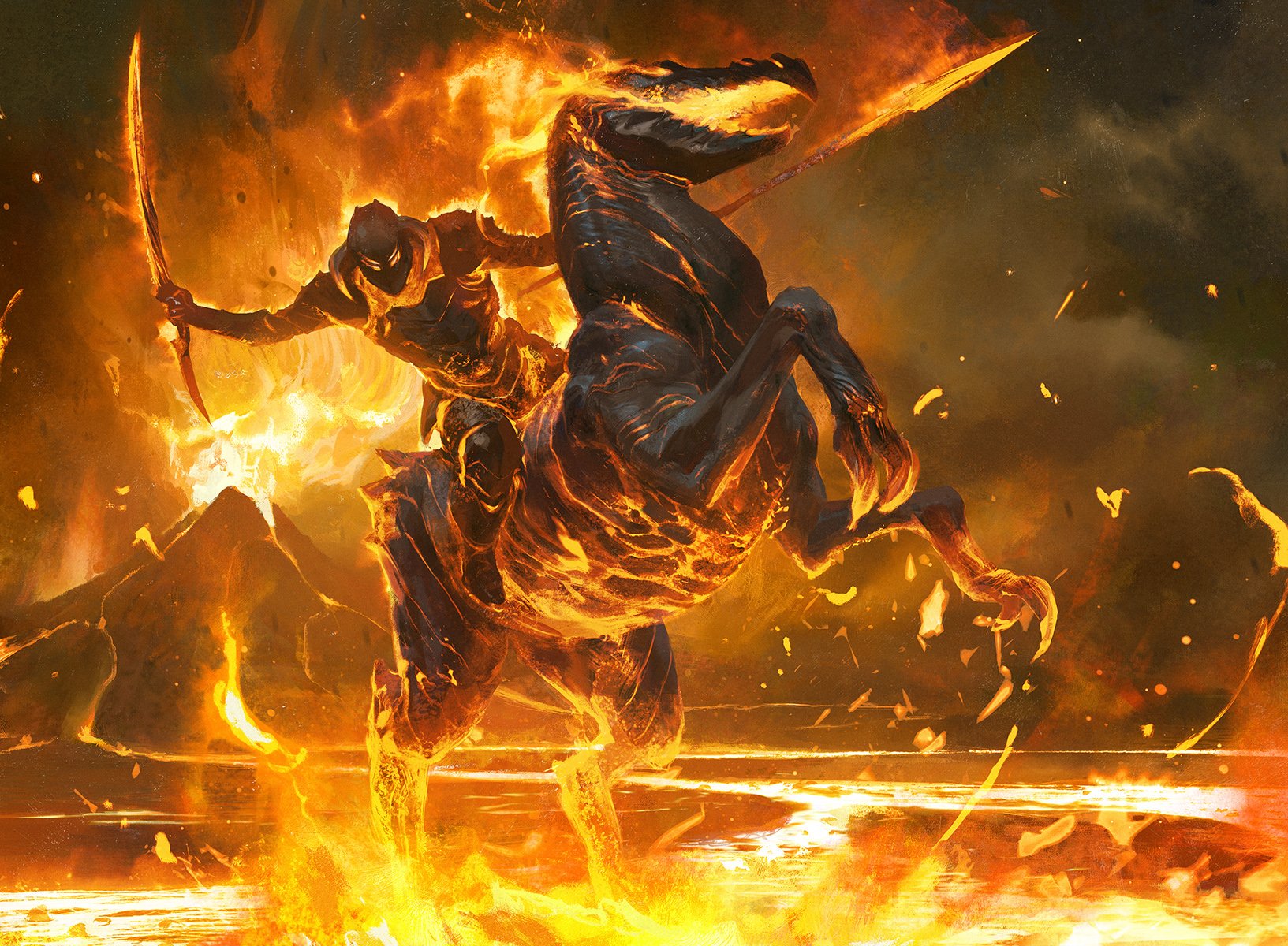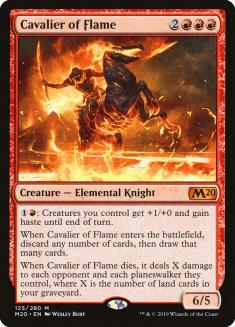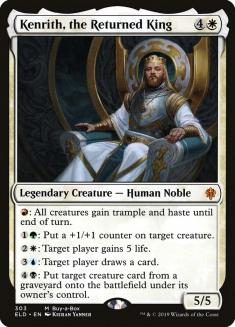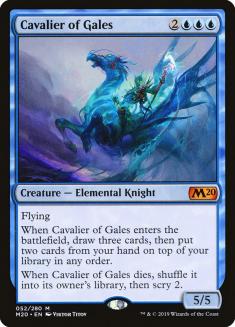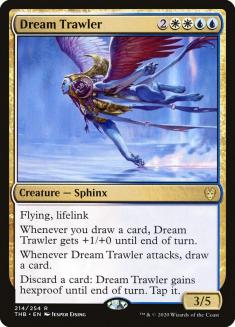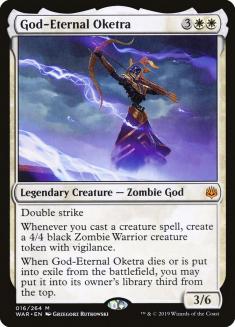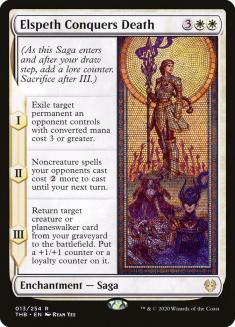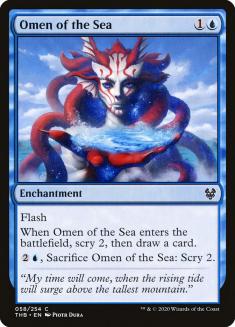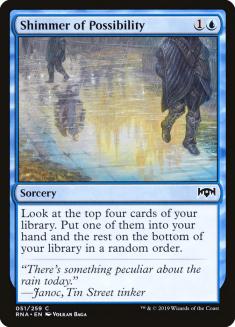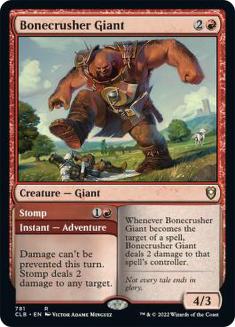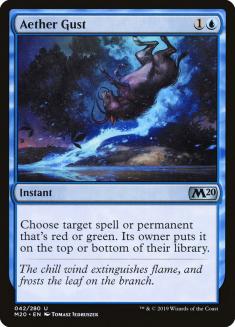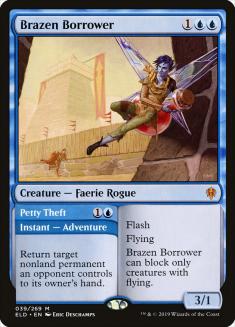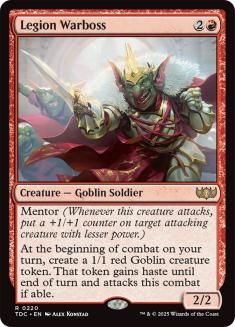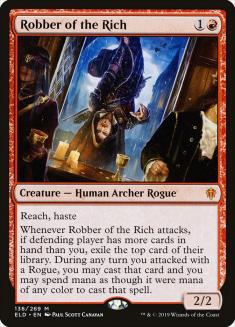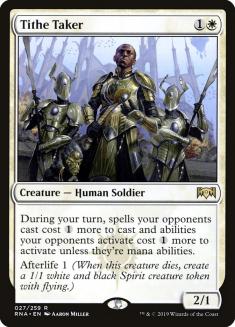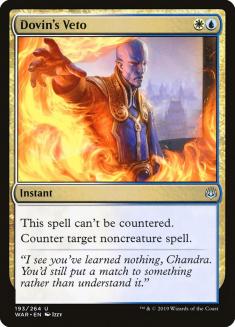Jeskai Fires has been a Tier 1 deck for a while (it was the most-played deck at Mythic Championship VII, for example), but the release of Theros Beyond Death powered up enough other archetypes that Jeskai Fires became momentarily forgotten. People still played it, but it wasn’t nearly as popular as it had been before.
Fast forward to World Championship XXVI, and Jeskai Fires was suddenly 25% of the field (which, granted, was only four people, but still). Not only was it prevalent, it was also a good deck, putting two of its four players in the Top 4. In that tournament, there were two different lists – Marcio Carvalho’s (and Javier Dominguez’s) and Gabriel Nassif (and Raphael Levy).
Creatures (19)
- 4 Sphinx of Foresight
- 4 Cavalier of Flame
- 2 Cavalier of Gales
- 3 Kenrith, the Returned King
- 4 Bonecrusher Giant
- 2 Dream Trawler
Planeswalkers (4)
Lands (27)
Spells (10)

After that, Jeskai Fires surged in popularity once again, and players were split between the two builds until Mani Davoudi (AKA Zapgaze) added a third contender by finishing in second place at DreamHack Anaheim:
Creatures (20)
- 4 Sphinx of Foresight
- 1 God-Eternal Oketra
- 4 Cavalier of Flame
- 2 Cavalier of Gales
- 2 Kenrith, the Returned King
- 4 Bonecrusher Giant
- 3 Brazen Borrower
Planeswalkers (4)
Lands (27)
Spells (9)
Sideboard

In today’s article, I’ll talk about the key differences in these lists and what I think are the best choices for this deck moving forward.
The Big Creatures
The most significant difference between the lists is the number of big creatures. Marcio ran eleven (four Cavalier of Flame; three Kenrith, the Returned King; two Cavalier of Gales; and two Dream Trawler). Nassif ran seven (four Cavalier of Flames and three Kenrith, the Returned King). Mani sort of split the difference with nine (two Kenrith, the Returned King; one God-Eternal Oketra; two Cavalier of Gales; and three Cavalier of Flame). He also had two Elspeth Conquers Death, which sort of fill the same space in the deck but behave very differently depending on how the game is going.
The number of big creatures determines how focused you are on your main gameplan (drawing and resolving Fires of Invention), and how much you want to hedge for the times that doesn’t come together. If you have a lot of big creatures, that maximizes your Fires of Invention draws while at the same time potentially making your non-Fires of Invention draws more clunky. If you have more cards like Brazen Borrower, Bonecrusher Giant, Deafening Clarion, or Aether Gust, you’re stronger in games where you don’t draw or resolve Fires of Invention, but you’re also not as powerful in the games where it stays on the battlefield.
Personally, I consider the minimum number of big creatures to be nine – that’s the number I liked in the previous iteration of Jeskai Fires and if I’m moving it in any direction it’s going to be upwards. I think that, with only seven (like in Nassif’s build), you run into the issue of not having enough of them way too often, which results in not winning the game even if you have an uncontested Fires of Invention, at which point a lot of the appeal of the deck is lost to me.
Which creatures should you play, though? I think four Cavalier of Flame and two Kenrith, the Returned King will be the norm in every list. Here’s how the other choices stack up in my opinion:
Cavalier of Gales was excellent before, but it has gotten significantly worse due to the prevalence of two cards – Narset, Parter of Veils and Mystical Dispute. Narset being on the battlefield results in a very high amount of shame concessions when your opponents cast Cavalier of Gales into it, but even when you are aware of the fact that it completely wrecks you, there’s not much you can do about it – you simply can’t cast the Cavalier. Mystical Dispute is often awkward against you later in the game, but Cavalier of Gales makes it much easier to use.
Overall, I still think Cavalier of Gales is good – having it on Turn 5 after a Fires of Invention is still a very powerful play. I would, however, play only two of them, and I would sideboard them out against decks that have both Narset and Mystical Dispute (which at this point is likely just Azorius Control).
Dream Trawler is a powerful card, but I don’t like it in Jeskai Fires. I think it goes too much against your main gameplan to justify playing; yeah, sometimes you’re going to go Turn 4 Fires into Turn 5 Kenrith or Cavalier into Turn 6 Dream Trawler and it’s going to be great, but what big creature wouldn’t be great in this spot? Dream Trawler is “win more” when you have everything going your way, and potentially “do nothing” if things are not going your way because it costs six mana. If you have Fires of Invention on the battlefield and you can’t cast anything on Turn 5 because the creature you have in your hand is Dream Trawler, that’s potentially devastating, as is having to hold onto an extra land that you could have discarded to Cavalier of Flame or scryed to the bottom with a Temple.
God-Eternal Oketra is an interesting one. It’s the worst five-drop to have by itself, but it’s very powerful if you have either Kenrith or Cavalier of Flame alongside it. Personally, I prefer the five-drops that get the chain going (such as Cavalier of Gales), since I feel like if I have two five-drops on the battlefield then I’m already in a good spot, but God-Eternal Oketra becomes better the more random creatures you have. In a build like Nassif’s, for example, with four Bonecrusher Giant and three Brazen Borrower, I actually like God-Eternal Oketra, as going Kenrith, the Returned King plus Brazen Borrower isn’t that powerful, but God-Eternal Oketra plus Brazen Borrower is.
Elspeth Conquers Death isn’t a creature, but it is a five-drop that will likely take the slot of one during deckbuilding. I think this card is very strong, and it’s one of the key cards in Azorius Control, but I don’t like it in the maindeck of Jeskai Fires; I think your Game 1 should be all about maximizing your deck’s best draws, and in your best draws having Elspeth Conquers Death over a big creature is embarrassing. Post-sideboard, once you start playing grindier and slower games, I think this is a reasonable card to have, but Game 1 I think you should go for raw power.
The Card Drawing
There are three potential options for card drawing – Omen of the Sea (Nassif’s choice), Shimmer of Possibility (Marcio’s choice), or nothing (Mani’s choice). I’m not a fan of “nothing,” since I believe you need at least some other way of fixing your early draws beyond Sphinx of Foresight (and in fact I would as a general rule play more than in these lists), but it’s close between the two other options.
At first, I thought Shimmer of Possibility was simply more powerful than Omen of the Sea – you don’t care that much about it being played as an instant, and Shimmer just dug deeper (and also better, because you see all the cards before making your decision). If you’re playing a combo deck (which Jeskai Fires definitely is, regardless of what I’ve been reading on Twitter about the definition of combo…), finding your combo pieces ultimately takes precedence over anything. Omen of the Sea does let you scry later on, which could end up in more digging overall, but the effect kind of overlaps with Castle Vantress and you often end many games with the effect unused even when you would want to use it.
There are, however, two advantages to Omen of the Sea. The first is that, even though you don’t care that much about it being playable at instant speed, you do care a little. Your deck has two-mana interaction (Petty Theft, Aether Gust, Stomp), so keeping mana up is relevant, but where it matters the most is post-sideboard, once you bring in even more interaction (such as Mystical Dispute). You often have to take out Shimmer of Possibility in sideboarded games, but Omen of the Sea is a bit better in this regard.
The second reason is Teferi, Time Raveler. In Azorius Control, bouncing your own Omen of the Sea comes up a lot. In Jeskai Fires, it comes up less often (you’re just trying to buy time sometimes), but it can still be relevant. When it is relevant, it’s hugely so – you get a free card drawing spell out of the deal. When you play against Azorius Control, for example, you often want to minus Teferi before they can cast Narset or Banishing Light it away, and you do so just to draw a card (Marcio did that several times against me in the finals). If you have Omen of the Sea on the battlefield, that sequence is much better for you.
Overall, I think it’s close between the two, but I like Omen of the Sea a bit better, especially if you’re playing Brazen Borrower or Aether Gust, since playing at instant speed becomes more important.
The Interaction
There is a lot of interaction that you can play in Jeskai Fires decks, and it really all depends on what you expect to face. Previously, I was a fan of Justice Strike, but nowadays the metagame doesn’t seem right for it – no one is playing Rotting Regisaur and the mirror isn’t that popular. The more popular the mirror becomes, the better Justice Strike is, but it’s probably not a good maindeck choice right now.
The decision I’m most curious about is four copies of Bonecrusher Giant on all the lists. Bonecrusher Giant isn’t awful versus Azorius Control, but it’s certainly not one of your best cards, and it’s also quite bad versus the mirror and Temur Reclamation. This makes it so that, in three of the four most popular matchups, I don’t want four copies of Bonecrusher Giant in my maindeck – it’s only really good versus Mono-Red Aggro. It’s also a much better card in post-sideboarded games as a general rule, when your Plan A gets disrupted and you’re more likely to want to beat down with random 4/3s.
Brazen Borrower and Aether Gust are similar to each other, but shine in different matchups. Having some Borrowers can come in handy versus Azorius decks (especially if they run Banishing Light or sideboarded Archon of Sun’s Grace), and it’s also better versus both the mirror and Temur Reclamation. Aether Gust is obviously a blank versus Azorius decks, but it’s the best of the three cards versus the other two matchups, and also very good versus Mono-Red Aggro.
Personally, I like Aether Gust in this deck. There’s enough filtering (Cavalier of Flame; Cavalier of Gales; Sphinx of Foresight; all the Temples) that you can afford a potentially dead card way more than most other decks and the upside is just so much higher. I think Brazen Borrower is worse as an interaction spell, but there’s value in having your interaction double up as a threat, even if it’s not a very significant one (though it can get quite significant once Cavalier of Flames is added to the mix). Besides, there is potentially another reason to want Brazen Borrower…
The Sideboard
The sideboard seems to be mostly standard, with the exception of “the creature of choice.” Marcio played Legion Warboss and Tithe Taker, while Nassif and Mani played Robber of the Rich. I think if you don’t play Brazen Borrower, Robber of the Rich isn’t good enough (it works very well with it both as a way to reduce the number of cards in your hand and as a way to trigger its ability, since Brazen Borrower is a Rogue), but assuming you do play Brazen Borrower in some number, then which creature should you play?
As far as power level goes, Legion Warboss blows the other two away. A Robber of the Rich can stay on the battlefield unanswered for nine turns and not win you the game – Legion Warboss will singlehandedly kill your opponent in less time than that. The main issue with Legion Warboss, of course, is that it costs three mana, and your deck already has creatures you can cast for three mana.
Another concern of costing three mana is that it can be answered by Absorb and Mystical Dispute if you’re on the draw. If you’re on the play, Legion Warboss slips through all their counterspells, but if you’re on the draw, it’s answered by all of them. This seems like it would be a great advantage of Robber of the Rich, since it slips through counterspells both on the play and on the draw, but the issue is that Robber of the Rich on the draw doesn’t do anything. You need to have fewer cards than your opponent to be able to steal a card, and on the draw this is not easy to accomplish. When we playtested this specific matchup, we had games where Robber of the Rich was cast on Turn 2, remained on the battlefield for several turns, and never got a card.
This, coupled with the fact that I don’t really want to play many Brazen Borrowers, makes me think the best sideboard play versus Azorius Control is a combination of Tithe Taker and Legion Warboss. Tithe Taker slips through all the counterspells, and then it makes sure your three-drop resolves – Legion Warboss for sure, and potentially Teferi, Time Raveler as well. If you’re on the play, they might not even be able to counter a Turn 4 Fires of Invention. The body on Tithe Taker isn’t what it used to be, since it can be blocked by the Wall token from The Birth of Meletis, but the same can be said about the Robber of the Rich.
The downside of this plan is that it’s worse versus Temur Reclamation. Robber of the Rich is pretty decent versus them, while Tithe Taker doesn’t really do anything (they don’t have to play on your turn). Besides, you need to cut something if you want to play both creatures, and that something is probably a couple of Mystical Disputes. So, whether you play Robber of the Rich or Tithe Taker + Legion Warboss is going to depend on whether you expect more Azorius Control or Temur Reclamation. It seems to me that Temur Reclamation is not as popular as it used to be right now, which would lead to tuning my deck against Azorius Control, but the popularity of Temur Adventures might swing the balance here (since it’s very good versus Azorius Control but bad versus Temur Reclamation). Right now, I would play the two creatures, but this might change soon.
The Counterspells
I’m not a big fan of counterspells in this deck in general. First, it’s a tap-out deck for the most part, even if you have Brazen Borrower and Omen of the Sea. Second, they don’t work at all with Fires of Invention. It’s good to have a few of them to force through Teferis and Legion Warbosses, but flooding on counterspells with your proactive deck is really problematic (especially considering that a lot of the decks you’d want counterspells against have Teferi, Time Raveler in them, so your counterspells might be dead in the middle of the game). I simply don’t see the appeal of a card like Dovin’s Veto, for example, unless you expect everyone to play Temur Reclamation. Given that I don’t expect that, I would play zero copies of Veto.
When all is said and done, here is the list I’d play:
Creatures (17)
- 4 Sphinx of Foresight
- 4 Cavalier of Flame
- 2 Cavalier of Gales
- 3 Kenrith, the Returned King
- 2 Bonecrusher Giant
- 2 Brazen Borrower
Planeswalkers (4)
Lands (27)
Spells (12)

This list should be worse against Temur Reclamation, since the sideboard doesn’t have many counterspells, but I think it’s overall better in other matchups, and unless Temur Reclamation surges in popularity again, this is the list I’d play. You will also be worse versus nonred aggro decks, since there are only two copies of Bonecrusher Giant, but those decks are not very popular right now either, and in return you should be better against decks like Jund Sacrifice, since there are more answers to Korvold, Fae-Cursed King.

